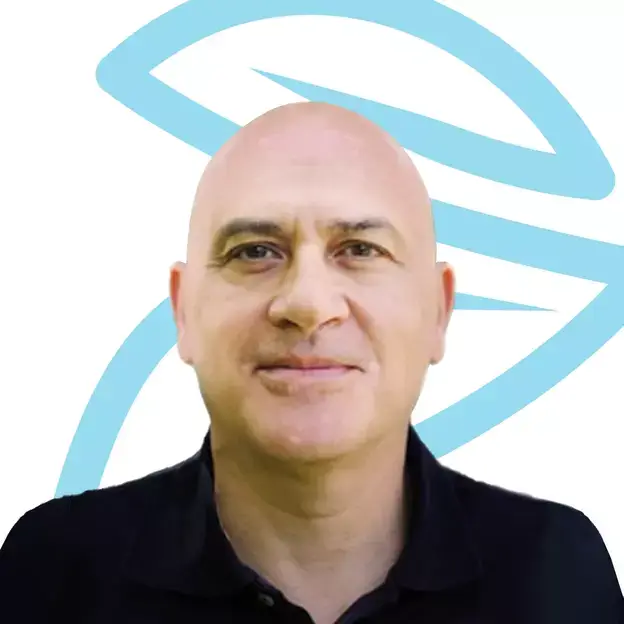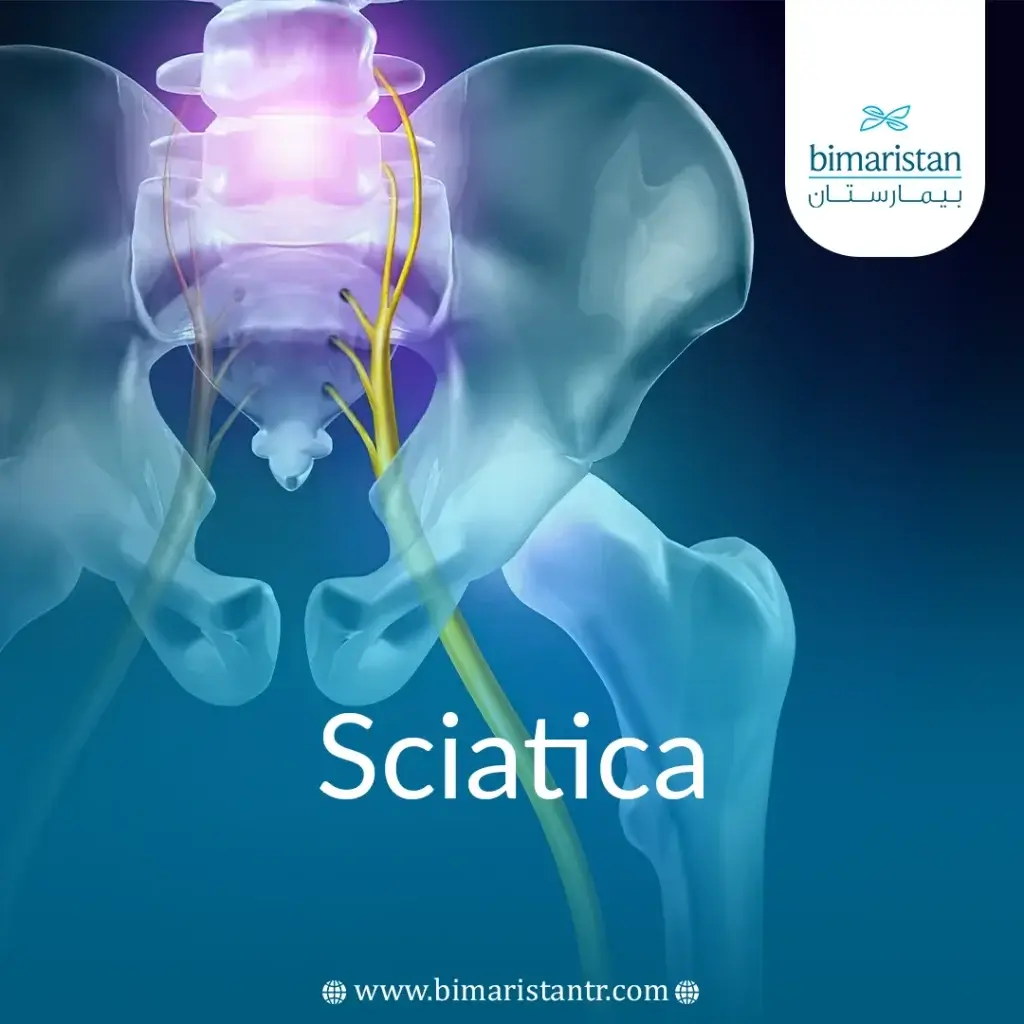Sciatica is one of the main causes of pain in the lower back. It runs along the path of the sciatic nerve from the back to the pelvic area to the legs and is often a symptom of a condition in the spinal cord.
It is an inflammation of the longest and largest nerves in the body, affecting several areas. It is one of the most common conditions suffered by women and men (women more often), and its treatment is important due to its impact on patients’ quality of life.
Sciatica treatment remains dependent on the causative condition, because as we mentioned, It is caused by another underlying condition that caused this compression or damage to the sciatic nerve, so how to get rid of the pain of sciatic nerve inflammation? And can sciatic nerve inflammation be treated at home? Follow us in this article.
Sciatica symptoms
A patient with sciatica may present with pain in the lower back, buttocks, and buttocks that extends to the thigh, lower leg, and even the sole of the foot. This pain is often localized on one side (unilateral) and rarely bilateral, a pain that feels like pinching and may be in the form of burning or electric shock.
The pain may be accompanied by numbness and tingling with a burning sensation along the sciatic nerve, and the symptoms may be accompanied by weakness and heaviness in the lower limb.
Symptoms can vary from numbness, tingling, and pain radiating to the sciatic nerve; the area around the buttocks may show pain while the lower affected areas show numbness or tingling, i.e., there is no particular pattern always seen in this disease.
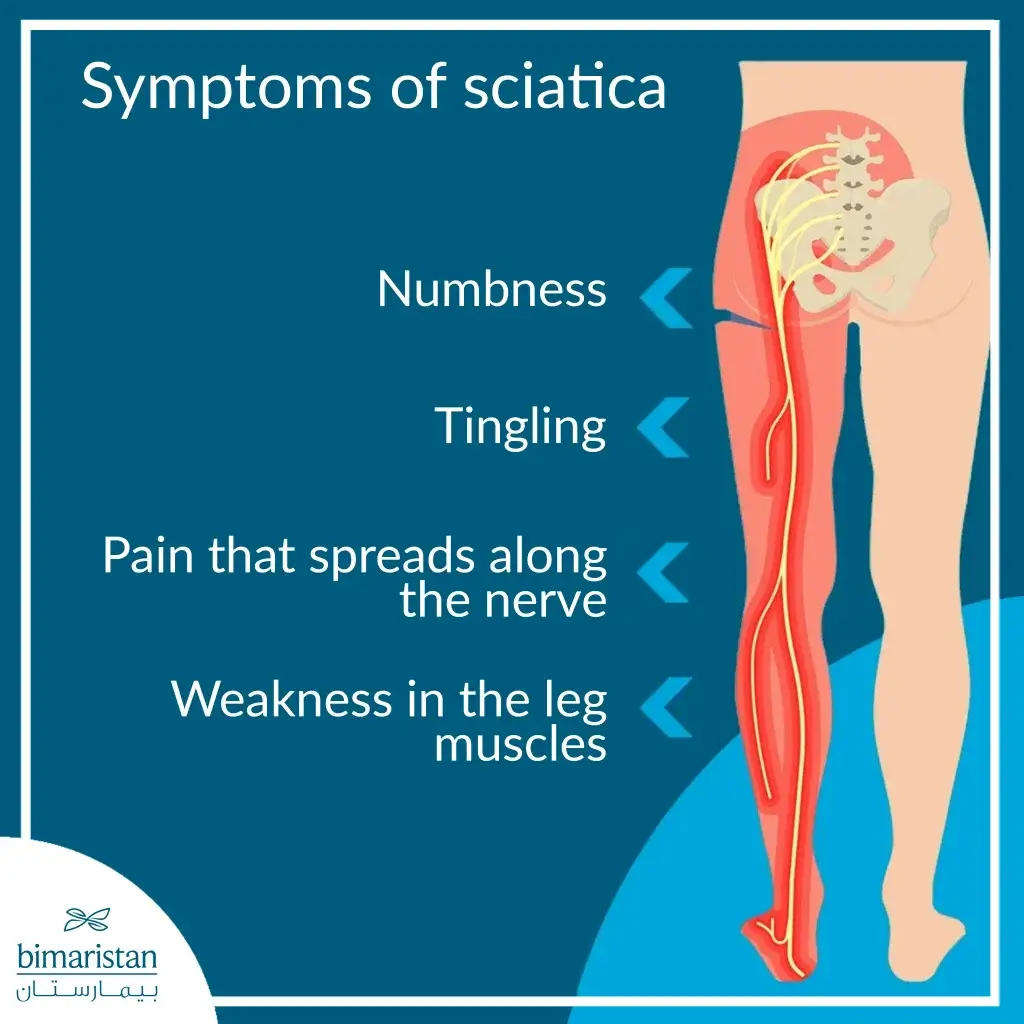
Read about: Spinal canal stenosis in the spine
Positions that aggravate the symptoms of Sciatica
You may feel the symptoms more in certain positions, and knowing these positions can help you avoid them or take it easy while trying to get in and out of them:
- The pain often increases when trying to stand, sit in an abnormal position, or stand for long periods of time (especially for those whose job requires them to stand for long hours), and symptoms may increase or decrease while lying down, causing sleeplessness.
- Holding air or squeezing too hard (such as during bowel movements) can worsen symptoms.
- Exacerbation of symptoms may be caused by coughing and sneezing.
Lying down with your knees slightly elevated and bent can help relieve symptoms.
Sciatic nerve: It is the longest and largest nerve in the body, originating from the nerve roots from L4 to S2, and it divides in the popliteal fossa into the tibial nerve and the common peroneal nerve.
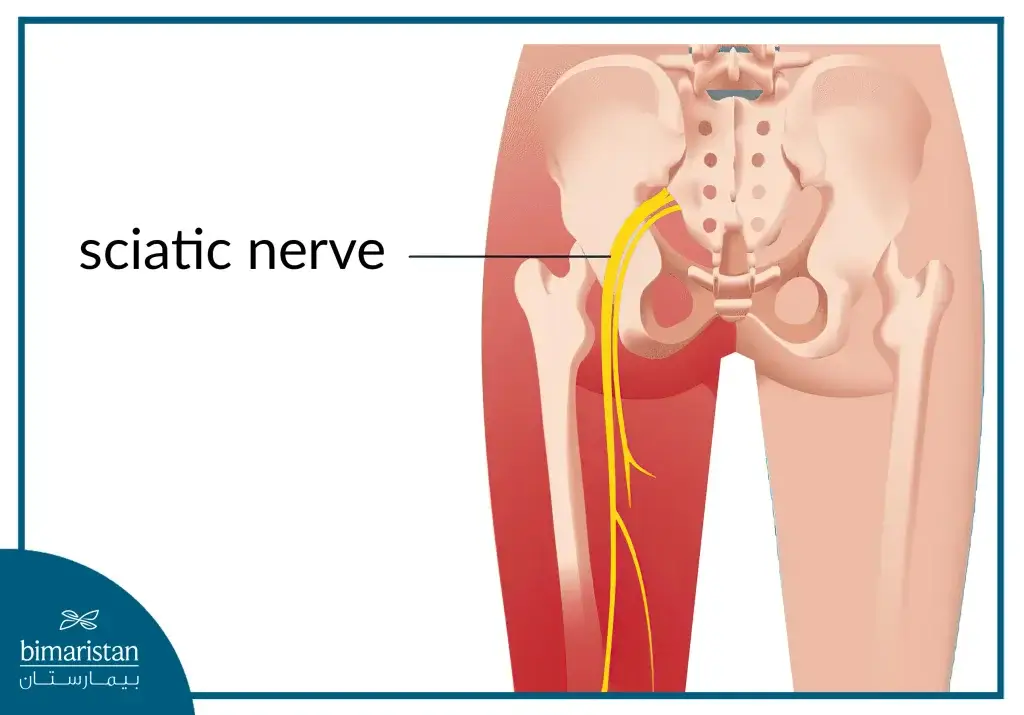
Sciatica causes
The causes are numerous, and anything that compresses or affects the sciatic nerve can cause sciatica (inflammation or irritation of the sciatic nerve).
The most common cause of this condition is a herniated disc (a herniated or bulging disc between the vertebrae in the lumbar region); as the herniated disc presses on the sciatic nerve roots, it causes the symptoms seen.
Stenosis of the spinal canal is one of the most important causes of this condition, especially in the elderly, in addition to rheumatoid arthritis
Other syndromes that cause this disease include:
- Degeneration and thinning of the intervertebral disc
- Spondylolisthesis
- Some bone formations or abnormal protrusions
- A tumor or hemorrhage pressing on the sciatic nerve
- Lumbar muscle spasm or pelvic muscle inflammation (such as piriformis muscle syndrome called pseudo-sciatica)
- Cauda equina syndrome
Read about: Spina bifida: All about the disease and how to treat it in Turkey.
Recognizing and evaluating sciatica
Many conditions may confuse the patient (and even the doctor), and they may think that they are symptoms. You should see a doctor as soon as possible and not rely on home remedies or folk recipes to treat such tricky cases, as some cases that share symptoms with sciatica may be serious and require ambulatory treatment.
Diseases that can present with symptoms similar to those of sciatica include:
- Acute ischemia or limb ischemia (an ambulatory condition that requires rapid medical intervention, or the patient will lose the affected limb)
- Acute compartment syndrome (compartment syndrome)
- Sacroiliac joint dysfunction
- Pott’s disease (bone tuberculosis)
The clinical history is one of the most important steps in diagnosing Sciatica. Low back pain (lower back pain) and symptoms of numbness, tingling, and weakness in the lower extremities guide the doctor in further investigating the cause of the pain.
Determining the source and cause of low back pain is a major challenge for doctors in Turkey, as radiographs may not accurately identify the cause of sciatica.
Computed tomography (CT) and magnetic resonance imaging (MRI) are the most important diagnostic methods for this condition, and electromyography (EMG) can also help in gaining insight into its cause.
Read more about: Diagnostic and therapeutic lumbar or spinal tap
Sciatica treatment in Turkey
The treatment of sciatica (inflammation of the sciatic nerve) depends on the cause of this condition in the human body. Home treatment, exercise, and lifestyle changes may be sufficient in some cases, and doctors in Turkey may resort to surgery in certain cases.
Sciatica at home
Conservative treatment of sciatica includes many methods of treatment, and the patient must follow the doctor’s instructions completely to ensure maximum benefit and avoid resorting to surgical treatment.
Conservative treatment includes medication, physical therapy, lumbar spinal manipulation, injection of medications into the sacral region (lower back), and finally, treatment with herbs and lifestyle modifications.
Medications to treat sciatica
The doctor can prescribe some medications for patients, but they are still painkillers and not a final solution to this issue, such as these medications:
- NSAIDs
- anticonvulsants
- Tricyclic antidepressants
- Opioid or, in rare cases, non-opioid analgesics
- Oral steroids
- Some muscle relaxants
Exercises to treat sciatica
Exercise, physical therapy, and even massage can help alleviate or even eliminate sciatica altogether.
Read more about: Lumbar Spondylolisthesis – Lumbar Spine Treatment in Turkey.
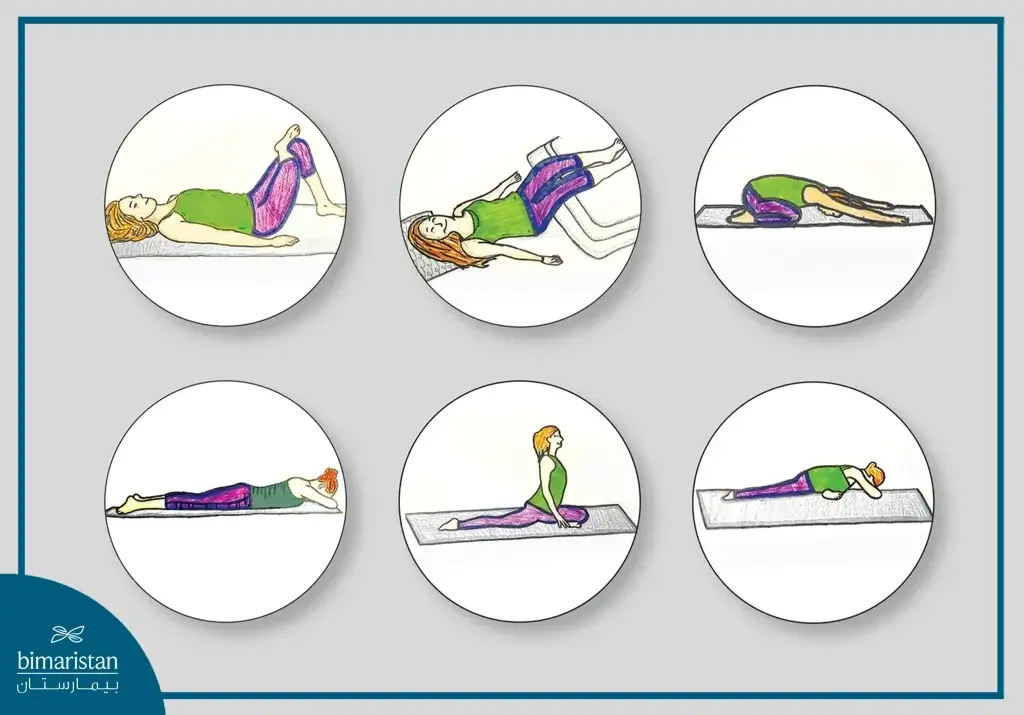
Injecting steroids topically
If the patient does not benefit from the previous treatment, pelvic or hip injections, and even epidural injections can be used.
It may target specific nerve roots in steroid injections, a more complex but precise method.
A single dose is usually enough to relieve symptoms, but up to 3 doses can be given yearly.
Also read in our website about: Injection disk treatment in Turkey.
Low back chiropractic
In a chiropractor’s office, the specialist manually adjusts the body’s spinal deformities, gives a glimpse into the cause of the lower back pain (sciatica), and helps the patient understand their body better.
Treating sciatica with herbs
Hot or cold compresses can help relieve lower back pain caused by sciatica (and other accompanying symptoms), and the patient may benefit from some folk recipes, but these are still complementary treatments:
- Turmeric powder
- Bitter Chamomile Oil
- Aloe Vera
- Garlic (effective pain reliever)
- Nutmeg
Read about: Herniated disc surgery in Turkey
Surgical treatment of Sciatica in Turkey
As we mentioned earlier, the treatment depends on its cause. If all previous treatments fail after six weeks of starting them, or if the condition is ambulatory and the patient has serious symptoms, doctors in Turkey resort to surgical treatment to solve this issue permanently.
Types of sciatica surgery in Turkey
- Minimally invasive laparoscopic herniated disc surgery in Turkey
- Laser Disc Treatment in Turkey
- Microscopic Disc Treatment in Turkey
- Treatment of spinal canal stenosis in Turkey (see the surgical treatment section to learn about the different types of surgical approaches such as laminectomy, laminoplasty, laminotomy, perforation, and even fusion of two vertebrae)
- Surgical treatment of lumbar spondylolisthesis in Turkey (the two most popular methods are decompression surgery and spinal stabilization surgery)
- Surgical removal of tumors or masses pressing on the sciatic nerve in Turkey
Some tips for the sciatic nerve (sciatica) patient
Lifestyle changes, weight loss, and dietary modifications are among the most important steps in getting rid of lower back pain (sciatica) once and for all, as being overweight and sitting for long periods are the most common causes of this condition.
Bimaristan Center offers an integrated plan for treating Sciatica. This condition is one of the most common causes of pain in the world, so the patient must pay attention to the type of pain and its spread and review the doctor as soon as possible. Although there are many treatment methods in Turkey, the solution remains in the hands of the patient when taking the first step toward treatment in Turkey.
Read more about:
Scoliosis; Learn about scoliosis treatment methods in Turkey
Tethered cord treatment in Turkey
Sympathetic Neurotomy | Hyperhidrosis Treatment in Turkey
Sources:
